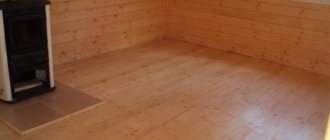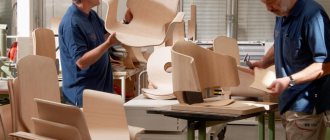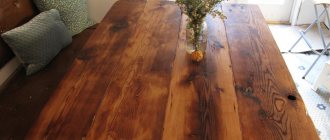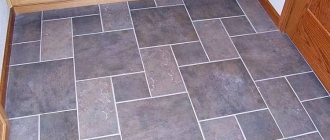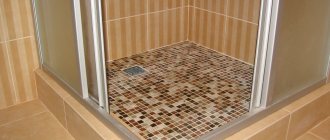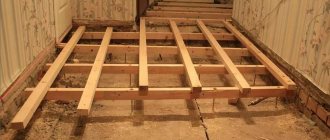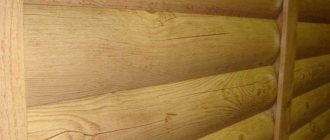Experienced craftsmen believe that laying tiles on a wooden floor is not the most reliable finishing method. It is better to completely dismantle the wooden structures, fill the base with concrete, make a screed and lay tiles on it. But this is not always possible. In private houses, floors are most often made of wood, and even on the first floor there can be a large distance from the floor level to the ground, filling which with concrete, even after crushed stone preparation, turns out to be difficult and unprofitable. In such cases, you have to either abandon the tiled covering or very carefully prepare the wooden base for its installation.
There are often communications laid under the floor that cannot be walled up in concrete Source mastertechmold.com
Disadvantages of finishing wood with ceramics
Ceramic products adhere well only to a solid, durable and immovable base. Violation of any of these requirements leads to their peeling, cracking, chipping and mowing of tile joints. Tiles cannot be laid on a wooden floor for another reason: these materials have completely different characteristics - hygroscopicity, coefficient of thermal expansion, vapor permeability. Therefore, combining them without damaging one of the materials is quite difficult.
Let us list the problems that arise with such floor finishing.
- The structure of a wooden floor with joists cannot boast of absolute immobility - the boards “play” under load, and the tiles rigidly glued to it begin to break.
- All wooden floor elements, including joists, are deformed and change their cross-sectional size under the influence of variable humidity, and such movements also negatively affect the integrity of the tile covering.
Mechanical damage to tiles is a common problem when laying them on a wooden floor Source carehomesuk.net
- The tree must “breathe,” but under an impenetrable ceramic shell it is deprived of this opportunity, and the base can quickly rot.
- The service life of wood and tiles is different; if the base begins to deteriorate, the coating will also be damaged, which will have to be removed to repair the main floor.
Therefore, before laying tiles on a wooden floor in a wooden house, you need to try to eliminate all possible problems, carefully strengthen and level the base, and protect it from destruction.
In addition, these materials have different heat capacities. Warm wood is pleasant to the touch, it is comfortable to walk on it with bare feet, which cannot be said about tiles or porcelain stoneware. You can make it warm by installing a heating system under the ceramic coating, but it will create additional problems associated with temperature changes that greatly affect the stability of the wood.
Heated floor system under tiles Source bitrix24.ua
Based on the above, the question of whether it is possible to lay tiles on a wooden floor cannot be answered unambiguously. If this is necessary, then it is possible, but first you will have to prepare the foundation very well, having first inspected its condition.
The initial stage of laying tiles
As already mentioned, preparing the base for the tiles is especially important.
It is most likely that the floor is installed on top of the joists. These are wooden transverse elements that act as supports. Their condition, as well as the appearance of the floorboards, must be carefully examined and, if necessary, defects corrected.
The algorithm of actions depends entirely on the specific situation.
- If the boards are very leaky, they are completely or partially removed, if the joists are in poor condition, they need to be replaced completely or partially, repaired and treated with special means.
- In some cases, given the circumstances, instead of the removed boards, another, more affordable material (OSB, chipboard or plywood sheet) can be placed on top of the joists.
- If both the top boards and joists are in good condition, they can be left as is, but additional leveling may be required.
Each of these scenarios requires a different tile installation option because the base was prepared differently.
Strengthening the load-bearing structure of the floor
The first thing to do is to completely open the floors, exposing the joists and floor beams. You can exclude this stage only if the house is new and you know for sure that the wooden “skeleton” of the floor is laid correctly - with all elements treated with an antiseptic, a damper gap is installed between the joists and the wall, and frequent steps are taken between adjacent joists.
If the house is more than 2-3 years old or you are not sure that the technological requirements were observed when installing the floor, it will be possible to lay tiles on a wooden floor only after it has been inspected and the structure has been strengthened.
Rotten beams may be found under the floor that will not withstand the weight of the ceramic coating Source imhonn.ru
Having opened the subfloor, the following activities are carried out:
- dismantle old rotted or cracked logs, laying new ones in their place;
- between the ends of the logs and the wall a compensation gap of about 10 mm is left;
- at a step of more than half a meter, intermediate logs are laid, which is necessary to increase the load-bearing capacity of the supporting structure and prevent sagging of the boards between the beams;
- align the upper edges of the lags in one plane, cutting off the protrusions and installing linings;
Leveling using a building level Source oteplicah.ru
See also: Catalog of companies that specialize in finishing materials and related work
- treat the frame on all sides with antiseptic impregnations in 2-3 layers, drying each one.
When deciding whether it is possible to lay tiles on a wooden floor from dismantled boards, they are inspected for rot and damage and discarded. Instead, lumber of the same thickness is prepared.
Advice! All wooden elements of the base must be dry. If the humidity is more than 18-20%, they will begin to deform when dried.
Before attaching the boardwalk, you can fill or lay insulation in the space between the joists that is not afraid of moisture - expanded clay, expanded polystyrene, polyurethane foam. To ventilate the boards, leave at least 1.5-2 cm of air space between the insulation and the flooring.
When laying antiseptic-treated boards on the joists, they also leave gaps:
- between the ends and the wall – 10 mm;
- between boards - 3-4 mm.
This is necessary so that when the wood expands, tension does not arise at the joints.
The decking is fastened with galvanized screws or nails, 2 pieces at each intersection with the joists.
If the floor is supposed to be leveled with a planer or sanded, the fastener heads are recessed into the wood Source chudopol.ru
Preparation of tools and materials
Set of tools:
- tape measure and ruler;
- building level;
- marking tape;
- stationery knife;
- electric drill with attachments and screwdriver;
- tile cutter;
- hacksaw;
- spatulas - regular and serrated;
- containers for mixing solutions;
- galvanized screws;
- crosses for tiles;
- rule.
List of materials:
- wood - boards, plywood, floorboards in sufficient quantities;
- waterproofing - any of your choice;
- damper tape;
- polyurethane foam;
- drying oil;
- sealant;
- antifungal and latex impregnation;
- adhesive for laying tiles or components for preparing mortar (cement, sand, water, additives);
- grout for seams.
Video description
How to dry level a wooden floor under porcelain tiles, see the video:
If the base is not stable enough, it is better to lay the dry screed in two layers with the joints offset. It is advisable to calculate so that the joints fall on supporting elements - joists or floor beams. For free expansion, small gaps 2-3 mm thick are left between the sheets, which are filled with elastic sealant after installation.
After cleaning from construction debris and wet cleaning, the finished screed is primed and dried. Ceramic tiles on a wooden floor are glued with polyurethane glue, which does not crack due to movement of the base.
In damp rooms, the wooden base needs additional protection from getting wet, so after priming it is covered with waterproofing in several layers, extending onto the walls. The seams between the sheets and the joints with the walls are additionally taped with reinforcing tape.
Choosing tiles
The floor should be tiled with anti-slip tiles. Matte textured varieties of floor tiles with a corrugated or rough surface are perfect.
You will have to discard thick tiles - a wooden floor is not resistant to high loads. The same applies to large-area ceramic elements - their installation will require more glue or mortar, which means the facing layer will be more massive.
It is better to opt for thick but light floor tiles, which will match the color and design of the main style of the room.
It should be taken into account that large tiles in small bathrooms will visually reduce and conceal the space.
Video description
How to properly waterproof wooden floors in bathrooms and other wet rooms is described in this video:
Wet screed
A wet screed is used when it is necessary to lay a heated floor carpet under the tiles, as well as to increase the service life of the finishing coating and waterproofing of the floor in wet rooms. Cement-sand screed creates a monolithic foundation without joints with high load-bearing capacity.
But it itself creates a large load on the wooden base, so the concrete layer should not exceed 3-3.5 cm. A smaller thickness is also undesirable, since a thin screed is fragile and can crack.
Scheme for laying tiles on a wooden floor using a wet screed Source derevostroika.ru
Selection of adhesive composition
For work on wooden bases, only special types of adhesives are suitable, which contain components with high elasticity. They must withstand the linear expansion of the boards, preventing the tiles from moving from the base and cracking.
These parameters correspond to the products of the following brands:
- Unis – super elastic adhesive and super polymer;
- Knauf Flex;
- Ceresit CM17, etc.
If a concrete screed was made on top of the floorboards, it is permissible to use a classic mortar based on sand and cement.
Among the non-standard methods offered by folk craftsmen, we can mention liquid nails and liquid glass (silicate glue)
In some cases, homemade mixtures of nitrocellulose varnish with polystyrene foam dissolved in gasoline or acetone are becoming popular.
Read more about tile adhesive for the bathroom in the article - How to choose adhesive for tiles in the bathroom
Important! When using homemade glue, there is no guarantee that the cladding will last long and be strong.
Video description
An example of installing a wet screed on a wooden floor in a private house is shown in the video:
The main disadvantage of this method of preparing the base is that the screed must be completely dry and gain strength before laying the tiles. This process lasts at least three weeks, and with high air humidity and temperatures below +10-15 degrees it can last even longer.
Tiles can be laid on a cement screed using regular tile adhesive, but it is better to use polyurethane adhesive. After the glue has dried, the seams are filled with epoxy grout.
Grouting joints
After finishing the laying work, the tiles are left for some time (1-2 days) so that the glue fixes the tiling. Then they begin to grout the tile joints. This will require the appropriate tools and materials.
It is recommended to choose special antifungal mixtures. This is a necessity in rooms with high humidity.
Apply the grout carefully with a rubber spatula so that the seams are equally beautiful. After the filler has dried, the tiles should be wiped with a dry cloth to remove any remaining mixture from the tiles.
Briefly about the main thing
Ceramics are quite difficult to “make friends” with wood, especially when it comes to covering a floor that experiences constant vibration loads. Wood expands and contracts under the influence of varying temperatures and humidity, while ceramics have little or no effect. Therefore, before laying tiles in a wooden house, the floors should be strengthened, leveled, protected from moisture and ensure their stability. This is done using a dry or wet screed, onto which the finishing coating is subsequently mounted.
Arrangement of a waterproofing layer
You can install waterproofing immediately after using latex impregnation, without waiting for it to harden. The waterproofing layer has important functional significance, so you should not neglect the basic nuances and principles of its arrangement.
We recommend watching - How to waterproof a bathroom under tiles?
Damping layer
Any rolled materials can be used as a waterproofing layer:
- parchment;
- glassine;
- bitumen paper;
- paraffin paper;
- thick polyethylene.
The materials are laid overlapping and secured with tape. For better protection, it is necessary that the layer extends at least 10 cm onto the walls.
To prevent deformation and moisture penetration, a layer of damper tape is used. It withstands temperature changes typical for a bathroom, prevents heat loss and reduces noise.
But the shock-absorbing properties of the damper tape are of particular value - it compensates for possible movements of the floorboards and fixes the coating.
Important! To maximize the compensation effect, the tape is laid on the subfloor with the elastic surface and the hard surface facing the ceramic tile side.
Installation of heating system
We will install electric heating; in all respects it is much better than water heating.
Step 1: Drill a hole in the wall for the thermostat. It is exactly the same size as the socket.
Drilling a hole for the thermostat
Thermostat installation location
Step 2. Cover the surface of the base with a special plastic waterproofing material.
Ready waterproofing
Important. Use only this type of mastic; hard ones will crack during linear vibrations of the heated floor.
Application of waterproofing material
Read the instructions for use and strictly follow the manufacturer's recommendations. It is easier to work with a small roller.
Step 3: Use waterproofing tape to seal the joint between the floor and the walls. The tape is first glued to the mastic, and then another layer of material is applied on top.
You also need to apply a special waterproofing tape
The top of the tape is also covered with mastic
Step 4. Lay out the electric heating mats, secure the sensors, and connect the electrical power cord. Carry out all work according to the instructions, it is included with each package.
Electric heated floor mats unfold
Mounting the temperature sensor
